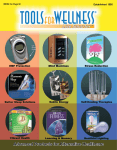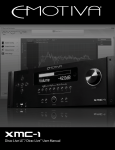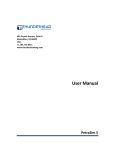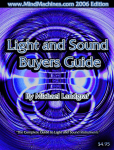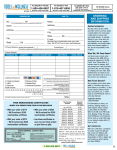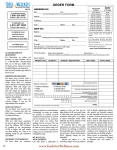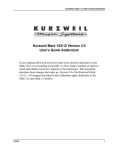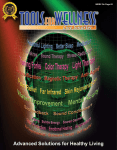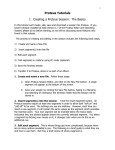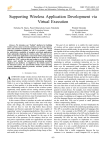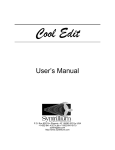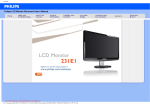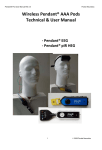Download iLightz Owners Manual 2.0.pub
Transcript
Manufactured by: Distributed by: Mind Gear, Inc. Owners Guide written by: Michael Landgraf Michael Landgraf Ent., LLC Tools For Wellness www.ToolsForWellness.com Medical Disclaimer "Light / Sound Systems" or "Mind Machines" have been on the market for years. Thousands of users have experienced many hours on them with virtually no reported ill effects. But there are some situations and conditions where use of our products is strongly discouraged. These devices create flickering light, which can cause seizures in persons with photosensitive epilepsy. You may be photosensitive and not know it. Even if you have never had a seizure, there is a small chance that you are photosensitive, and exposure to flashing lights can cause YOU to have a seizure. If you are not willing to accept this risk, please do not use Mind Gear L/S systems. Mind Gear products are designed for recreational purposes and personal exploration ONLY. No medical claims are made for Mind Gear products, express or implied. They are NOT medical devices and should not be used for the relief of any medical condition. Please consult with your licensed medical practitioner prior to use for any other purpose as the machine is not intended as a replacement for medical or psychological treatment. Our products are not intended to affect the structure or any function of the human body. These products are not approved for any purpose by the FDA. If you or anyone else who will use this machine are subject to any form of seizures, epilepsy or visual photosensitivity, are using a pacemaker, suffering cardiac arrhythmia or other heart disorders, currently taking stimulants, tranquilizers or psychotropic medication, specifically including illicit drugs and alcohol, please do not use our or any other Light / Sound system. Your experience should feel pleasant and we recommend that you set the volume and light intensity levels with your EYES CLOSED before you or anyone you loan your system to, uses it. Photosensitive Epilepsy Photosensitive Epilepsy is a relatively rare condition, affecting approximately 1 person in 4000. Persons with this condition are susceptible to seizures evoked by flickering lights, such as those produced by a light / sound machine. The information included here on photosensitive epilepsy is mostly from the book "Photosensitive Epilepsy". Most persons with photosensitive epilepsy have a first seizure during their teenage years (75% by age 20). About half of initial seizures are induced by watching television. Some persons who are susceptible during their teenage years outgrow the condition, about 25% by age 25. As a result, adults over age 25 who have never had a seizure have about 1 chance in 20,000 of being photosensitive and not know it. So for a person who has not had a seizure, the likelihood of being photosensitive varies from 1 in 4000 for children to 1 in 20,000 for adults over 25. Remember, even if you have never had a seizure, there is a small chance that you are photosensitive and a light / sound session could cause a seizure in YOU! 2 Table of Contents Medical Disclaimer . . . . . . . . . . . . . . . . . . . . . . . . . . . . . . . . . . . . . . . . . . . . . . . . . . . . . 2 Introduction to iLightz . . . . . . . . . . . . . . . . . . . . . . . . . . . . . . . . . . . . . . . . . . . . . . . . . . 4 The iLightz Package . . . . . . . . . . . . . . . . . . . . . . . . . . . . . . . . . . . . . . . . . . . . . . . . . . . . 5 Background Information . . . . . . . . . . . . . . . . . . . . . . . . . . . . . . . . . . . . . . . . . . . . . . . . . 6 Installing Batteries & Quick Starting Your iLightz Helpful Hints .......................... 9 . . . . . . . . . . . . . . . . . . . . . . . . . . . . . . . . . . . . . . . . . . . . . . . . . . . . . . . . . . 12 Keypad . . . . . . . . . . . . . . . . . . . . . . . . . . . . . . . . . . . . . . . . . . . . . . . . . . . . . . . . . . . . . . . 14 Programs . . . . . . . . . . . . . . . . . . . . . . . . . . . . . . . . . . . . . . . . . . . . . . . . . . . . . . . . . . . . . 15 iLightz Session List . . . . . . . . . . . . . . . . . . . . . . . . . . . . . . . . . . . . . . . . . . . . . . . . . . . . . 16 Programming Worksheet . . . . . . . . . . . . . . . . . . . . . . . . . . . . . . . . . . . . . . . . . . . . . . . . . 18 Manual Mode . . . . . . . . . . . . . . . . . . . . . . . . . . . . . . . . . . . . . . . . . . . . . . . . . . . . . . . . . 19 Settings AutoPilot . . . . . . . . . . . . . . . . . . . . . . . . . . . . . . . . . . . . . . . . . . . . . . . . . . . . . . . . . . . . . . 21 . . . . . . . . . . . . . . . . . . . . . . . . . . . . . . . . . . . . . . . . . . . . . . . . . . . . . . . . . . . . . 22 iLightz Color Selection . . . . . . . . . . . . . . . . . . . . . . . . . . . . . . . . . . . . . . . . . . . . . . . . . . 23 Adding Music & Spoken Word to Your iLightz Sessions . . . . . . . . . . . . . . . . . . . . . . 26 FAQ & Troubleshooting Tips . . . . . . . . . . . . . . . . . . . . . . . . . . . . . . . . . . . . . . . . . . . . . 27 Warranty & Returns . . . . . . . . . . . . . . . . . . . . . . . . . . . . . . . . . . . . . . . . . . . . . . . . . . . . 30 3 Introducing the most sophisticated, yet easy to use mind machine available . . . 4 The iLightz Package On back of iLightz: A/C adapter port Lightframe port for connecting Common Power (CP) lightframes by Mind Gear. External input port for connecting the stereo patch cord to the headphone port of a CD player, stereo audio sound source, computer, etc. USB port for connecting the iLightz unique Color Matrix lightframes. On right side of iLightz: Headphone port. USB port for downloading. Please refer to chart below for system comparisons: iLightz™ iLightz™ Pro Number of Built-in Programs Frequency Range Manual Operation 50 0.5-40Hz Yes 75 0.5-40Hz Yes User Programmable Autopilot Programs Turbosonix Compatible No, But Upgradeable No Yes Yes 5 Yes USB Port External Audio Input Stereo Patch Cord Soft On/Off Custom Color Function User Upgradeable Firmware Yes Yes Yes Yes No, But Upgradeable Yes, With Optional USB Cable Yes Yes Yes Yes Yes Yes Color Matrix™ RGB Glasses Regular LED Glasses Regular RGB Glasses Open-Eye Style Glasses No, But Upgradeable Yes, Standard No, But Optional No, But Optional Yes No, But Optional No, But Optional No, But Optional Custom Color Shifting Color Tracking Function No, But Upgradeable No, But Upgradeable Yes Yes USB Cable Included A/C Adapter Included No, But Optional No, But Optional Yes Yes NOTE: Optional / Upgradeable Optional means the unit is already capable of supporting the accessory without a firmware upgrade. Upgradeable means the unit requires a firmware update to support the function or accessory. NOTE: Headphones are an option. Any headphones will work, but if you do not own a pair, Mind Gear offers excellent deluxe headphones for your listening pleasure. 5 Background Information about Light & Sound Stimulation (Excerpts from “Mind States: An Introduction to Light & Sound Technology”) What Is An iLightz Light & Sound Instrument? An iLightz light and sound instrument is a mind entrainment tool. The method by which this entrainment occurs is known as the Frequency Following Response (FFR). Through the use of audio (headphones) and visual (eye frames with LEDs or RGB-based LEDchips) stimulation, participants are gently guided into specific states of mind. Each audio beat and light pulse is a specific frequency. Our minds "think" in terms of frequency. Brainwaves change frequencies based on neural activity within the brain, be it by hearing, touch, smell, vision and/or taste. These senses respond to activity from the environment and transmits that information to the brain via electrical signals. Hearing and vision are considered favorable senses for affecting brainwaves safely. By presenting these beats and pulses to the brain, within a few minutes, the brain begins to mimic or follow the same frequencies as the stimuli (the beats and pulses). This process is referred to as entrainment. In essence, the iLightz light and sound instrument speaks to the mind in it's own language- the language of frequency. The Frequency Following Response that the mind experiences through light and sound stimulation provides a focus for the brain. This focus safely quells any internal dialogue or "brain chatter", and enables the participant to reach more quickly and effectively the optimum state of mind targeted for the task at hand (i.e., energizing, learning, relaxing, etc.). So a light and sound instrument can entrain your mind to experience different levels of your consciousness. As such it is a tool, but it is a very enjoyable tool. For a whole new musical experience combine your favorite songs with an iLightz light and sound session. You can actually see, as well as hear, the music as it travels along your brainwaves. It is also for exercising your mind. After all, your brain is like a large muscle. Use light and sound to train your brain to run faster and more efficiently; to show you how to find and access your "zone" and to help clean up that mental fuzz that occasionally interrupts our mental clarity. Here is a brief summary of the evolution of light and sound: Humanity has been aware of how outside stimulation can affect the mind long before recorded history. We can share that same awareness by sitting around a campfire. Watching the flickering flames creates a soothing, calming sensation within the mind. This same affect is also experienced with rhythmic drumbeats. The continuous, repetitive beats tend to generate a calming affect, while faster repetitions create a more energetic sensation. Within the twentieth century, researchers have developed this awareness into highly beneficial instrumentation. Although scientists knew flickering light and audio beats affected our frame of mind, they were unable to prove how that interaction existed. Then in 1924, Hans Burger, a German psychiatrist, published pictures depicting electrical activity of the human brain. From the discovery of these "wavy" lines emerged a new scientific field called electroencephalography. 6 These wavy lines are simple to visualize. Just picture a series of peaks and valleys, much like the skyline of a mountain range. When you are asleep, in Delta, those peaks and valleys are at both their highest and lowest points and appear to be spread out. As you gradually awaken and become more alert, progressing from Theta into Alpha, the peaks and valleys begin to shrink in size and are spaced closer together. Then when you are in your normal waking state, Beta, this "mountain range" is at it's smallest level, with very little space separating the peaks from the valleys. During the 1940's several researchers, including W. Gray Walter, utilized powerful electronic strobes with new versions of EEG instrumentation to alter brainwave activity, producing states of profound relaxation and imagery. In 1949, brainwave signals were brought to the screen with the invention of the Tuposcope. This breakthrough allowed the tracking of brainwave patterns (Beta, Alpha, Theta and Delta). Within five years, hundreds of hospitals were compiling EEG's. In the 1950's and 1960's, research on Zen and Yoga meditators showed a predominance of alpha and theta waves during meditation. These findings were made through the data collected by researchers including M.A. Wanger of the University of California at Los Angeles; B.K. Bagchi of the University of Michigan School of Medicine; and B.K. Anand of the All India Institute of Medical Sciences in New Delhi (Ditson-Sommer 1995). During the late 1960's and into the 1970's interest in producing altered states without chemicals increased. Alpha EEG feedback by Dr. Joe Kamiya at Langley-Porter Neuropsychiatric Institute in San Francisco aided in initiating the age of biofeedback. Others, including Jack Schwarz and Richard Townsend, continued their investigations of rhythmic light and sound combinations, with emphasis on hemispheric brain synchronization and EEG entrainment (Budzynski 1991). It was during the decade of the 1970's that the first patent was obtained for a light and sound instrument. This occurred in 1974, with the patent obtained by Seymour Charas. He was a scientist at New York City College and for reasons unknown, never put his device into production (Hutchison 1990). In the 1980's there were major breakthroughs in microelectronics. From this came the development of instruments that contained various programs of sound frequency changes and light intensity modulation. In a study by Marchal Gilula, M.D., of Life Energies Research Institute of Coconut Grove, Florida, clinical research on Multiple Afferent Sensory Stimulation (MASS) was conducted. His research found that light and sound (MASS) equipment elicited an 80% subject response with deep states of mind and body relaxation (Ditson-Sommer 1995). For the past several years, clinical devices utilizing light and sound stimulation have been successfully used in relaxation and learning enhancement. For the general public, small portable units became available. Still, this technology is so new that the majority of us do not know how to use it. Those that do know are using it for commercial purposes, ranging from audio/video cassettes, CDs and DVDs to workshops and seminars. 7 How Are Frequencies Associated With Brainwaves? Brainwaves are the electrical wave patterns generated in every person's brain. These waves vary according to level of consciousness, sub-consciousness and unconsciousness and are characterized by four distinct types of brainwaves. Each of these electrical wave patterns have distinctly different ways of perceiving, processing, learning and knowing information (Hoiberg 1989). All of these brain waves are produced at all times. However, a predominance of a specific desired brainwave state can be created at will, which allows a person to potentialize his or her capabilities towards achieving human excellence. Brainwave frequencies are described in terms of hertz (Hz), or cycles per second, which are measured by an electroencephalogram (EEG). The four general categories of brainwave frequencies and their main characteristics are: Gamma brainwave frequencies are a high frequency pattern beginning around thirty-five hertz. There has been some evidence that gamma frequencies are associated with states of peak performance. Most light and sound instruments have the capability to generate gamma frequencies. While in this brainwave state, sensations are centered on being mentally, emotionally and physically "charged" or extremely energized. These frequencies are the highest known brainwave patterns, but are considered by some researchers to be part of the beta frequency category. Beta brainwaves are the next highest frequency pattern, ranging from thirteen to approximately thirty-four hertz, and can be separated into three sub-categories. The first is high beta, ranging from nineteen to thirty-four hertz. When high beta is the dominant brainwave state, anxiety and stress are most likely to occur. The second sub-category is mid beta, with frequencies ranging from fifteen to eighteen hertz. Mid beta is characterized by action, with focus on external surroundings. The third is SMR beta (Sensorimotor Rhythm), ranging from thirteen to fifteen hertz. While in this state, focus is also on external surroundings, but the individual is more relaxed than in mid beta. Within SMR is fourteen hertz, which is gaining attention from researchers and clinicians utilizing EEG/neurofeedback instrumentation. However, the true benefit of creating fourteen hertz in humans has yet to be determined. Generally speaking, beta brainwaves are characterized by logical, analytical and intellectual thinking, verbal communication and awareness of surroundings. Alpha brainwaves are a frequency pattern ranging from eight to twelve hertz. They most commonly occur when we are calm and relaxed, yet mentally alert. These brainwaves are also present during daydreaming. Theta brainwaves range from four to seven hertz, characterized by being deeply relaxed and inwardly focused. This brainwave state is also associated with rapid learning and the assimilation of new information with high retention, heightened motivation to activate goals, bursts of creativity, insight and new behavior patterns. Delta brainwaves range from five-tenths to three hertz and are associated with being extremely relaxed, characterized by sleep. 8 Researchers have proven that brainwave frequencies determine what brainwave state is being experienced at any given time (Budzynski 1991). By measuring the production of brainwaves through the utilization of EEG (electroencephalogram) equipment, the frequencies that produce these various brain states can be tracked on a computer monitor. As mentioned earlier, these frequencies are generated in every person's brain, and are the result of outside stimulation that has been passed to the brain via electrical signals from our different senses. Light and sound instruments stimulate the neural activity of our vision and hearing, and can safely guide our minds to produce specific frequencies that are associated with the four general brainwave categories (Hutchison 1992). “Mind States” (ISBN 0-9662596-0-2): written by Michael Landgraf ( www.MichaelLandgraf.com ) Quick Start Guide for iLightz The first step in setting up your iLightz is … Installing batteries or using the A/C Adapter: Before you begin your iLightz experience, installing batteries is necessary. On the upper part of the back of your unit, you will see the battery compartment. Unlatch the lid and insert four “AA” batteries as shown. You will enjoy several hours of iLightz sessions with just one four-pack of “AA” batteries. If you have the iLightz Pro which includes the A/C adapter, simply connect the adapter to the iLightz adapter port located on the top left side of your unit. And should you choose to purchase an A/C adapter later, it is recommended that you purchase the correct type from an authorized Mind Gear retailer. The A/C adapter specifications are: 6V DC 800mA with the connector having a positive tip. Your second step is connecting the lightframes and headphones … Connect Common Power (“CP”) lightframes to the port marked “LIGHT”. Connect the Color Matrix lightframes of the iLightz Pro to the port marked “COLOR MATRIX”. When not using an iPOD in conjunction with your iLightz, select an external sound source such as a CD player or audio receiver. Connect one end of the stereo patch cord to the headphone port of the external sound source and the other end to the port marked “EXT. INPUT”. Connect your headphones to the port marked “SOUND”. When using the recommended AC Adapter, connect to port marked “6VDC/800MA”. 9 After set up is complete press the center key on the iLightz keypad ... To turn on your iLightz press the center key and the ‘Welcome’ screen appears. It times out after 5 seconds, replaced by the ‘Main Menu’ screen (or simply press the center key once to go directly to the ‘Main Menu’). You are now ready to begin your journey into mind exploration, gently and with absolutely no conscious effort. Enjoy! The iLightz and iLightz Pro have 9 total keys. 4 are on the outer perimeter, the remaining are on the 5 way keypad in the center (for complete description refer to “Keypad Function” section). Following are general navigation guidelines for the keys: • Pressing any key will turn the unit “on” and display the welcome screen. • Press any key again and the main menu is displayed. • Generally, the outside keys will navigate up and down as will the up/down center keys. I.E. the top two outside keys move up, the two bottom move down (our unit is ambidextrous). • Except when in manual mode at which time the outer keys act to change the value of the selected parameter up/down. • When running a program the right outer keys control the “volume” of the iLightz sound. The left outer keys control the “brightness/intensity” of the lightframes. This is so a user can change these parameters without having to look at the keypad. • The round center key always acts as an “enter/select” key EXCEPT if pressed and held for more than 2 seconds which always turns unit off. 10 • You can also turn the unit off by selecting “power off” from the main menu. • The “left” center key always acts as an ”escape/back” key. The only exception is when you are in the manual mode when it acts simply as a “left” directional key. • All menus will “roll over”. In other words, if you are at the top of a menu list and press one of the “up” buttons, the cursor will “roll over” and drop to the bottom of the menu. • When in the “manual mode” you must use the 5-way center keys to navigate and the outer keys to adjust the values. Pressing the center key will “return/escape” you out of the manual mode. The iLightz has the ability to display 511 (512 if you include “black”) different colors when using our proprietary “color matrix” glasses. We provide easy access to any of these colors through the color menu. The following selections are available: • Custom color: press the enter key to adjust the color settings for red-green-blue ratios. • White • Red • Green • Blue • Color matrix 1 – This is a color tracking function defined below • Color matrix 2– This is a color tracking function defined below • Color matrix 3– This is a color tracking function defined below Color Matrix 1: 0.5 - 3.4 Hz Blue 3.5 - 6.8 Hz Green 7.0 - 13.5 Hz Orange (equal red & green, no blue) 14.0 - 27.5 Hz White (equal R, G, & B) 28.0 - 40.0 Hz White (equal R, G, & B) Color Matrix 2: 0.5 - 3.4 Hz Magenta (equal red & blue, no green) 11 3.5 - 6.8 Hz cyan (equal blue & green, no red) 7.0 - 13.5 Hz Orange (equal red & green, no blue) 14.0 - 27.5 Hz Red 28.0 - 40.0 Hz White (equal R, G, & B) Color Matrix 3: 0.5 - 3.4 Hz Blue 3.5 - 6.8 Hz cyan (equal blue & green, no red) 7.0 - 13.5 Hz Magenta (equal red & blue, no green) 14.0 - 27.5 Hz Orange (equal red & green, no blue) 28.0 - 40.0 Hz White (equal R, G, & B) Random Color Matrix: Randomly selects a new color (1 of 511 possible combinations) each time the frequency changes between the five frequency bins (0.5-3.4, 3.5-6.8, 7.0-13.5, 14.0-27.5, and 28.0-40.0). For custom color adjustments the following “outer keys” are used: · The upper left adjusts the Red values 0-7 · The lower left adjusts the Green values 0-7 · The lower right adjust the Blue values 0-7 · The upper right does not do anything Helpful Hints -Always read your iLightz owners guide. It is the best way to maximize your session experiences. -Always have the volume at a comfortable level. Blasting the audio tones will not make a session more effective. 12 -When wearing lightframes, have the brightness set at a level you find enjoyable. The more you use your instrument, the more tolerable to brighter intensities your eyes should become. Like audio tones, you do not need to have the brightness set at the maximum level for it to be effective for you. -To achieve the best possible results, use your system on a daily basis for the first 30 days. -Wear clothing that is comfortable and loose fitting while doing sessions. -Make using your system a routine. Try to set aside a specific time and place for you to use your system. -Have a goal in mind before beginning a session and say it verbally to yourself. Maybe it is a problem you need to solve, an idea you need to organize or some stress that needs to be released. -Try to draw a mental picture of the goal you have in mind. Try to make it as detailed as possible. Can you picture the results? During the session, try not to drift from this picture. Try to remain focused on your goal and mental picture. Should you find your thoughts drifting, just refocus. -Keep a blanket or comforter handy. Blood flow to your extremities is reduced during deep relaxation and you might find yourself a bit chilled during the session. -Be aware of how you are breathing. Try to have your breaths come in a deep, regular fashion. Try this: Inhale (count 1,2,3,4), Hold (2,3,4), Release (1,2,3,4) or mentally say to yourself as you breathe: Quiet/Cope/Focus. -Keep a log or journal of your session experiences. After a session, remain still and listen to any thoughts that come into your mind. Answers do not always immediately surface after a session. Sometimes they surface hours or even a few days later. Be conscious of this while you go about your normal daily routine. -To determine what works best for you, become aware of your energy levels, sleep patterns and stress levels over the course of the first four weeks. -Do not be overwhelmed by your light and sound instrument. The more you use it, the easier it becomes to use. Should you ever have a problem or question, never hesitate to call Michael Landgraf or Mind Gear directly. -Please remember: When I first started using a light and sound instrument (an IQ-III in 1985), there was no one I could call unless I wanted to make a long distance phone call. I still have a difficult time programming my audio / visual entertainment system. So if I can figure this technology out, believe me, you can too! 13 Keypad Functions USE TOP LEFT KEY FOR: SCROLL UP BRIGHTNESS UP USE TOP RIGHT KEY FOR: SCROLL UP VOLUME UP USE THE LEFT CENTER KEY AS THE ‘BACK’ KEY USE 5-WAY CENTER KEYS FOR: TOP CENTER—UP BOTTOM CENTER—DOWN CENTER KEY—ENTER / SELECT LEFT CENTER KEY—BACK ONE STEP USE BOTTOM LEFT KEY FOR: SCROLL DOWN BRIGHTNESS DOWN USE BOTTOM RIGHT KEY FOR: SCROLL DOWN VOLUME DOWN The iLightz has 9 total keys: 4 are on the outer perimeter and the center is a 5-way keypad. The following are general navigation guidelines for the keys: • Pressing any key will turn the unit “on” and display the welcome screen. • Press any key again and the main menu is displayed. • Generally, the outside keys will navigate up and down as will the up/down center keys. The top two outside keys move up and the two bottom keys move down (our unit is ambidextrous). • When in manual mode the outer keys act to change the value of the selected parameter up/down. • When running a program the right outer keys control the “volume” of the iLightz sound. The left outer keys control the “brightness/intensity” of the glasses. This is so a user can change these parameters without having to look at the keypad. • The round center key always acts as an “enter/select” key EXCEPT if pressed and held for more than 2 seconds which always turns unit off. • You can also turn the unit off by selecting “power off” from the main menu. • The “left” center key always acts as an ”escape/back” key. The only exception is when you are in the manual mode it acts as a simple “left” directional key. • All menus will “roll over”. In other words, if you are at the top of a menu list and press one of the “up” buttons, the cursor will “roll over” and drop to the bottom of the menu. • When in the “manual mode” you must use the 5-way center keys to navigate and the outer keys to adjust the values. Pressing the center key will “return/escape” you out of the manual mode. 14 • When running a program the rightPrograms outer keys control the “volume” of the iLightz sound. The left outer keys control the “brightness/intensity” of the glasses. This is so a user can change these parameters without having to look at the keypad. • The round center key always acts as an “enter/select” key EXCEPT if pressed and held for more than 2 seconds which always turns unit off. • When selecting Programs from the main menu screen (by pressing the center / enter) key on your keypad, you are taken to the menu pictured above, which allows you complete access to all sessions stored in your iLightz. Favorites: This is the area where you can store your favorite sessions. Go to the session you would like to add in the iLightz program list and press the right (center) arrow key. You will be asked if you would like to save that session. If yes, press the enter (center) key. If you would like to delete a session from your list of favorites, simply select the session and hit the right (center) arrow key. You will be asked if you would like to delete the selected session. If yes, press the enter (center) key. All: is the entire selection of built-in sessions to choose from. Simply scroll down (or up) to the session you wish to experience, press the center key (enter) and the ten second countdown begins for that session. The complete list of programs is on the following two pages. We suggest you print out the list of programs to keep near your iLightz for easy reference. Autopilot: This is the area on the iLightz Pro that contains the five special “AP” programs (refer to AutoPilot section for complete information). User: This area stores the programs (sessions) that you have created. To access a particular session, simply scroll down to the session you want and hit enter (the center key). Create New: Here is where you can design your own sessions. By using the top/bottom/left/right arrows of the center key, you can move from one session component to the next. By pressing the outside keys, either the top right or left and bottom right or left, you can change the value for each particular session component. For ease in creating new sessions you will find a worksheet that follows the list of programs pages. Printing a few copies of the program worksheet will make creating new sessions very easy. 15 iLightz Session List Program P01 P02 P03 P04 P05 P06 P07 P08 P09 P10 P11 P12 P13 P14 P15 P16 P17 P18 P19 P20 P21 P22 P23 P24 P25 P26 P27 P28 P29 P30 P31 P32 P33 P34 P35 P36 P37 P38 P39 P40 P41 P42 P43 P44 Time 10 15 10 20 30 30 30 10 15 30 15 15 20 20 30 30 30 30 50 25 10 22 60 20 5 23 40 20 30 30 30 68 35 30 30 30 15 20 30 30 15 30 30 30 Description Target Freq. Quick Alpha relaxer Slow Ramp Alpha Magic 11 Schumann's Alpha Schumann Resonance High Stress Alpha Low Stress Alpha Quick Fix Alpha Break Meditation Medicine Quick Theta Accelerated Learning 9 O'clock High Multi-Theta Deep Theta Relaxation, learning Intimate Theta/Delta Insomniacs Dream Mind Expander Mental Gymnastics Sharpening the mind Fire of the Mind Relaxed Creativity Basic Brain Tune-up Demo The Balancer Delta Force Morning Glory Magic 14 Mind Massager Alpha Theta Train Power Nap Carnival Ride Creative Monster Alpha Ramp Alpha Wave Coffee Break Problem Solver Multi Theta Theta Wave Tune-up Deep Relaxation Energized Learning Meditation Machine 16 11 8 11 11, 7.83 7.83 7.83, 5 10, 7 7 7 7, 5, 3 7.83, 5 6, 10 9 7.83, 4 5, 3 5, 3 5, 3 2 1 7.83, 6, 3, 1 Many Many Many 5 11, 7.83, 5 5 1-40 4,1 10,18 14 7 thru 15 5 thru 12 3 thru 6 2 16 20 20 18 7.83 30 20 7.83 12 12 24 Notes Relaxation Relaxation Relaxation Relaxation Relaxation For High Stress For Low Stress All in high Alpha Lower Alpha Theta meditation Meditate, dreaming Absorbing Info Relaxation, Energy Theta Freq. Low Theta Range Meditate, Learning Close to sleep Help to fall asleep Theta Freq., sleep Mental enjoyment Mental Exercise Energy, visuals Deep Relaxation Mental exercise. Demo.features Creativity Lucid dreaming Waking up A.D.D. Protocol Mental Tune-up Creative/Learn Sleep/Learning Energy creativity Energized Relaxation Relaxation Relaxation Creativity Learning Meditation Mental Tune-up Relaxation Learning Meditation P45 P46 P47 P48 P49 P50 30 30 36 15 30 20 Dreamy Delight High Energy I High Energy II Quick Break Relaxed Creativity Quick Learning 26 10 16 12 12 7.83 Sleep Creativity Creativity Rejuvenation Problem Solving Learning The 25 Additional Built-in Sessions for iLightz Pro*: P51 P52 P53 P54 P55 P56 P57 P58 P59 P60 P61 P62 P63 P64 P65 P66 P67 P68 P69 P70 P71 P72 P73 P74 P75 15 22 36 40 26 75 45 18 45 40 20 30 15 35 28 36 65 36 30 30 25 25 30 17 13 Alpha Relax Theta Relax Deep Relax Earth Medit8 Siesta Escape Sound Sleep 14Hz Trainer Mental Repro Hypnosis Mood Britenr Mind Exercise Learning Mood Crosstalk Problem Solvr Memory Recall Hyper Cri8tvt Creativity High Creativ High Energy Gethingsdun Pure Motv8ion Sportswave Pump-U-Up Mind Ride 9 Mid-Day Trainer 5 Focused Learning 3 Theta Relaxation 7.83 Schulmann Resonance 0.5 Afternoon Nap 0.5 For Long Trips 0.5 Go To Sleep 14 SMR Training 5 Deep Theta Hypnosis 6-7.83 Hypnosis Protocol 30, 40 Seasonal Affective Disorder 9, 5 Alpha / Theta 6 Learning New Material 7 Performance Trainer 4, 9 Creative Solutions 5, 10 Alpha / Theta Ramp 40, 7 Enhanced Creativity 7 Project Solver 4, 6 Problem Solving & Creative Thought 18 Beta Booster 24, 30 Afternoon Power Boost 30 Mental Motivation 22, 30 General Use Sports Prep 24, 30 Pre-Workout Many Fun & Stimulating Ride AutoPilot Programs: Five special “always different” sessions. See AutoPilot section for information on how to save your favorite iLightz Pro AutoPilot sessions: 30 30 30 30 30 Delta Theta Alpha Beta Gamma 1 to 4 4 to 7 7 to 14 15 to 30 30 to 40 Sleep Meditative Alert, Aware High energy Very High energy *iLightz Pro sessions designed by Christopher Oliver and Michael Landgraf 17 PROGRAMMING WORKSHEET PROGRAM NAME: Time 1 2 3 4 5 6 7 8 9 10 11 12 13 14 15 16 17 18 19 20 21 22 23 24 25 26 27 28 29 30 31 32 33 34 35 36 37 38 PROGRAM NUMBER: Frequency Mode Pulse Width Pitch Volume Intensity Tone Manual Mode To move from one value to the next, use center keys or Manual / Back. To change any of the following particular values, use right side keys on keypad (Top right = increase, bottom right = decrease) iPodV = volume control for iPod COL = light stimulation color mix FREQ = frequency stimulation TON = tone (binaural or pulsed beats) PHS = phase DC = duty cycle PITCH = note scale (1 F# - 36 F) IN = light stimulation intensity (brightness level) VOL = audio stimulation (sound level) Stimulation Functions: There are nine functions in your iLightz that can be selected for display and control. One of the nine function lights will be highlighted, telling you which function is selected. To select a different function, use center keys or Manual / Back. The current value of the selected function is always shown in the display, and the right side keys on keypad (top right = increase, bottom right = decrease) are used to change any of the specific values. iPod: Adjusts the audio sound level / volume control of your iPod. COL: The iLightz has the ability to display 511 (512 if you include “black”) different colors when using our proprietary “color matrix” glasses. Choices include: blue, green, red, white, TSX (Turbosonix), CM1, CM2, CM3, RCM and RGB (Red-Green-Blue). For RGB custom color adjustments the following “outer keys” are used: · The upper left adjusts the Red values 0-7 · The lower left adjusts the Green values 0-7 · The lower right adjust the Blue values 0-7 · The upper right does not do anything. Frequency: Ranges from 0.5-40.0 Hz.. The FREQUENCY function controls the rate of stimulation pulses in the lightframes and in the earphones in all pulsed tone selections. When binaural sound is selected, it controls the difference, or beat frequency of the two tones. This function controls the frequency of entrainment of brain waves. 19 Tone: Pulsed stimulation is equal sound energy at each frequency. Binaural beat stimulation creates two continuous tones, separated in frequency by the selected FREQUENCY function value. The mind processes sound in such a way that you seem to hear, and sometimes feel, the frequency differences or beat frequency of the two tones. Phase: The PHASE function controls the phasing of the stimulation to the four stimulation channels (right eye, left eye, right ear, left ear). If two stimulation channels are on at once, they are said to be in phase. If one is on while the other is off, they are out of phase or alternating. Duty Cycle: This function controls the percentage of the total cycle time that stimulation is on. The default value 50% represents 50% on, 50% off. A DUTY CYCLE display of 40% means 40% on, 60% off; 30% means 30% on, 70% off, etc. With the ability to adjust the Duty Cycle from 10% to 90%, you have the enjoyment of experiencing a variety of stimulating sensations. But there is more. Press the up button past 90% and you will see B2 and B3, short for Blend 2 and Blend 3 respectively. These two features are unique to the iLightz system. The Blend feature provides smooth transitions between mode changes during a program. This feature can only be activated prior to the execution of a program, and is enabled at that time. These selections will 'soften' the transitions between mode changes in the built-in or custom program. Do not choose blend while designing and entering the phase selections of a custom program, simply 'switch' it on or off, just prior to starting a program, meaning the Blend option is not applicable in manual mode. To enable the Blend feature, follow these steps: go to the Duty Cycle, press the up key past 90% and you will see B2, press up once more for B3. Selecting either option will activate that particular mode for the next program you run. Should you prefer to have Blend activated for all programs, select it as a default setting in your Personal Preference Program. To disable the Blend feature, simply return to the duty cycle portion in the Manual Mode area and select a stimulation cycle other than B2 or B3. Pitch: Ranges from 1 to 36 notes. The pitch of the pulsed tone and binaural sound is controlled by this function. Intensity: Ranges from 0-100. The INTENSITY function controls the brightness of the lights in your stimulation lightframes. Always keep the brightness of your lightframes at a comfortable level. Volume: Ranges from 0-100. The VOLUME function controls the sound level in the headphones, but not the external sound source volume (CD player, MP3, audio stereo system, pc, etc.). Use your external sound source volume control to control external volume. 20 Settings “Personal Preferences” enables you to predetermine the values of sessions and remembers those values until you decide to change them. This saves you time by not having to adjust the values each time you experience a particular session. The “Backlight” setting is for choosing how long you want the menu screen display to be lighted. You can choose to have the backlight always off, always on or lighted for 2, 5, 10 or 20 seconds each time you press a key on the pad. You can always access this area to change the length of value. “Contrast” enables you the choice of text format and percentage of contrast desired. “About” is where you will find the model, firmware and serial numbers of your iLightz system. “Turbosonix” selection enables you to turn the feature on or off. Note: When scrolling through the different menu screens, pressing the left center key enables you to return to the previous screen. Should you need to pause a session while it is running, press the center key. To resume the session, simply press the center key again. To stop a session, press and hold the enter (center) key down for approximately two seconds. This will turn off your iLightz unit. Personal Preference Program: All functions have built-in default values that are in effect until you change them. Some functions, particularly VOLUME and INTENSITY, can be distinctly personal and you may prefer some value other than the built-in value. To save you the inconvenience of setting your preferred values each time the system is turned on, the PERSONAL PREFERENCE PROGRAM is provided. PPP remains constant and will only change when you adjust your personal preferences. Variables stored under personal preferences include recently run programs, iPod volume, iLightz volume, frequency, tone, phase, duty cycle, pitch, light intensity and choice of lightframes (Common Power, RGB 10 or Color Matrix). Backlight is the length of time the iLightz menu display is illuminated. Contrast enables you to choose whether you prefer normal or highlighted text and the percentage of contrast that appeals to you. About lists the model number, firmware number and serial number of your iLightz unit. Turbosonix is a unique iLightz feature that enables users to synchronize the music of a Turbosonix CD with the pulsed lights and audio stimulation of an iLightz program. Not only will you receive the full benefits of an iLightz session, but you will be able to experience the entertaining sensation that Turbosonix CDs offer. While in the TurboSonix mode the only color available if using the color matrix lightframes is white –meaning all colors are “on”. The user can have different colors only by using RGB 10 lightframes and manually setting their preferred color. This only applies when in the “TurboSonix” mode. 21 Shift is a special feature that allows the changes in color stimulation to gently ramp from one color to the next. The result is a gentle and gradual seven second transition that is much more comfortable on the eyes and far less of a jolt on the mind when compared to digital jumps in color stimulation used in other types of multi-color capable lightframes. The SHIFT feature generates a very soft change between colors that promotes session entrainment, allowing the mind to remain focused. AutoPilot Programs To access the AutoPilot programs, press iLightz Pro’s center key and the "Welcome" screen appears. Press the same key again and the "Main Menu" screen comes up. Press the right bottom key twice to scroll down to the "AutoPilot" selection. Press the center key once to enter the "AutoPilot" category. You will have three choices: Play / Run, Create New and Delete. Select Play / Run, press the center key once more and you will go to the various AutoPilot programs. There are five AP sessions: Delta (sleep), Theta (deep relaxation), Alpha (focused relaxation), Beta (energize) and Gamma (peak performance). Use the bottom right key to scroll down to the session of your choice. Once you have chosen the session you want, press the center key once to begin that particular AutoPilot program. Autopilot or AP for short, contains five programs that have been added to the original 75 programs found in the iLightz Pro. Each AP program is assigned a category of brainwave frequencies. They are Super Beta (30-40 hertz), Beta (13-30 Hz ), Alpha (8-12 Hz), Theta (4-7 Hz) and Delta (1-3 Hz). Each time a particular AP program is run, your iLightz Pro will generate a NEW & UNIQUE program targeted to the range specific to it! For example, each time an Alpha AUTOPILOT program is selected the system will automatically generate a new and unique program that will have target frequencies in the Alpha range. Furthermore, if you like and enjoy the program that the AUTOPILOT feature generates, you will have the option to save the program when it is finished! This AP feature provides virtually an unlimited number of built-in programs and is only available from Mind Gear. Starting an AP program: Beginning an AP program is exactly the same as running any other program. First you must determine which brainwave frequency range you wish to be stimulated at. Again, your choices are Super Beta, Beta, Alpha, Theta and Delta. Once you have made your decision, all you have to do is select the appropriate program and press the enter (center) key and your iLightz Pro will begin the 10 second countdown just like any other program. Please note that all AP programs are preset to run for 30 minutes. You can change the length of time on these programs just like any other (during the ten second countdown, press the center key and the session length adjustment screen appears). To save an AP program, press right arrow key. You will be asked if you would like to save it. Press enter. After experiencing the various AP sessions, you can save any session as a favorite, delete any or all of them and also create your own AP sessions (see menu screen above). 22 iLightz Color Selection When using the iLightz Pro Color Matrix lightframes, insert the lightframes into the USB port located in the center slot on the front of your iLightz unit. When using RGB 10, Common Power (CP) closed-eye or openeye lightframes insert the lightframe jack into the ‘Light’ port on the left front side of your iLightz. Note: If you have the iLightz Pro, you can run both the Color Matrix and Common Power lightframes simultaneously for two user capability. To access the ‘Color’ screen on your iLightz, press the center key. The first screen to appear will be the ‘Welcome’ screen. Press the center key again and the ‘Menu’ comes up. Scroll down to ‘Color’ and press the center key once more. You will now be in the area that enables you to choose the type of color stimulation you desire. By selecting the ‘Custom Color’ choice, you will be able to fully maximize the benefits of your iLightz Pro Color Matrix lightframes. These lightframes have the ability to generate 511 (512 if you include black) different colors. The following will assist you in determining which selection will best meet your needs: • White • Red • Green • Blue The following color tracking functions are described on the next page: • Color matrix 1 • Color matrix 2 • Color matrix 3 • Rnd Color matrix 23 Color Matrix 1: 0.5 - 3.4 Hz Blue 3.5 - 6.8 Hz Green 7.0 - 13.5 Hz Orange (equal red & green, no blue) 14.0 - 27.5 Hz White (equal R, G, & B) 28.0 - 40.0 Hz White (equal R, G, & B) Color Matrix 2: 0.5 - 3.4 Hz Magenta (equal red & blue, no green) 3.5 - 6.8 Hz cyan (equal blue & green, no red) 7.0 - 13.5 Hz Orange (equal red & green, no blue) 14.0 - 27.5 Hz Red 28.0 - 40.0 Hz White (equal R, G, & B) Color Matrix 3: 0.5 - 3.4 Hz Blue 3.5 - 6.8 Hz cyan (equal blue & green, no red) 7.0 - 13.5 Hz Magenta (equal red & blue, no green) 14.0 - 27.5 Hz Orange (equal red & green, no blue) 28.0 - 40.0 Hz White (equal R, G, & B) Random Color Matrix: Randomly selects a new color (1 of 511 possible combinations) each time the frequency changes between the five frequency bins (0.5-3.4, 3.5-6.8, 7.0-13.5, 14.0-27.5, and 28.0-40.0) 24 For custom color adjustments the following “outer keys” are used: · The upper left adjusts the Red values 0-7 · The lower left adjusts the Green values 0-7 · The lower right adjust the Blue values 0-7 · The upper right does not do anything. When using the iLightz RGB 10 style lightframes, the following chart will assist you in selecting the correct color you wish to experience: RGB 10 Lightframes PURE RED ULTRA RED ROSE QUARTZ YELLOW CALIFORNIA GOLD “WHITE” PURE GREEN AQUA PURE BLUE INDIGO VIOLET SWITCHES “ON” Red RED RED, Green, Blue Red, Green RED, Green Red, Green, Blue Green Green, Blue Blue Blue, RED Blue, Red Located on both the left and right sides of the RGB 10 lightframes are four color selection switches, allowing for left / right independent color control. The right four switches control the right eye color and the left four control the left eye. When a switch is to the left (next to the numbers one through four) it is in the "OFF" mode. Likewise, when each switch is to the right (the side with ON printed on the top right of the switch) it is in the "ON" mode. To select the color you desire, simply refer to the color key above and set the color switch(es) accordingly. For example, for PURE BLUE switch number one “ON” in both switches while all other switches should be to the left or “OFF”. For INDIGO, switch one and three will be on, two and four will be off. For all other common power lightframes, whether using closed or open eye styles, simply plug the lightframe jack into the left front ‘Light’ port. Remember: You can preset the color brightness / intensity of the color stimulation by choosing the desired level in the Personal Preference section of your iLightz. 25 Adding Music Or Spoken Word To Your Light & Sound Sessions Words can never fully describe the sensations you will experience when you combine your favorite musical selection with a light and sound program. Try it and you will understand. With iLightz being iPod friendly, the combination of listening to your favorite songs and experiencing a light and sound session has never been easier. First, choose which iLightz session you feel like playing. Then access the audio file in your iPod and decide which selection you would like to listen to. Hit play, then pause, and insert unit into the iPod port of your iLightz. When the ten second countdown for your iLightz session reaches zero, both the iLightz session and iPod selection will begin playing. Please Note: Before docking your iPod on the iLightz system, please insert the iPod adaptor that came with your iPod into the iLightz' iPod adaptor cavity. If your iPod did not come with an adaptor or you have misplaced it, please check with your local iPod accessory retailer for purchasing the correct adaptor or a multiple adaptor kit. If you dock your iPod on the iLightz without an adaptor or an incorrect adaptor, the iPod will not fit securely on the iLightz docking connector and you risk damaging the iLightz docking connector. Such damage is not covered by the warranty. iLightz iPod cavity without adapter iLightz iPod cavity with adapter If you do not have an iPod, no problem! The iLightz has a port on the right rear side of the unit designed specifically for the stereo patch cord that is included with your iLightz system. Just connect that cord to the external input port and the other end to the headphone port of your CD player, cassette deck, computer or any audio sound source that has a headphone port. Adjust the volume of the music via your sound source and the audio beats of the light and sound session via the iLightz. Do you enjoy rock and roll? Try listening to an energize (high beta and gamma frequencies) session to the accompaniment of the Stones or AC/DC. Audiogasm by Thomas Michael can also be an excellent choice. Almost all fast-paced music combined with high frequency sessions can get you proverbially "wired". Rock not your style? Heart beating too fast already? Need to slow down and shed that stress? Go the other way. Try listening to slower-paced music with sessions in the alpha and/or theta frequency range. After experiencing this type of session, you won't need to swallow that valium. You will feel naturally relaxed. Try this method with your favorite selection of "soft" music or environmental sound effects. Like I said, the experience is very hard to describe. What if you are dealing with some issues and you have a self-help CD to assist you in overcoming your problems? Combine it with a light and sound session in the alpha and/or theta frequency range. 26 By using light and sound while listening to the spoken words, you should find it easier to accept the information that is being spoken compared to just listening to the words by itself. Why? Because utilizing light and sound will take you to the level of consciousness where your mind is more acceptable to new suggestions and change. Are you a student or are you facing a promotional exam at work? What do you do with all those notes you've been taking? Try this: In your own voice, make an audio cassette or CD based on your notes. Listen to this cassette or CD in conjunction with an alpha or theta session, or a combination of both. Whichever works best for you. I have had too many clients tell me alpha works best or theta works best, for me to be any more specific. The important thing is you will know what works best for you. And you should know within a matter of one or two days. You will realize you have increased memory retention of what you need to know. Plus you should experience less anxiety associated with your upcoming exam. But if you procrastinate or put off studying until the last minute, don't even bother trying this method. Instead, skip the exam and by a self-help CD (see above paragraph). Frequently Asked Questions & Troubleshooting Tips When should the batteries be replaced: On the MENU screen, you will see a small battery and five bars, gradually increasing in size from low to high. This is located in the top right corner in each screen. When four or five of the bars are in 'bold', the batteries are still strong. When only two or three are in bold, it is a good idea to make sure you have four extra AA batteries available. When only one bar is in bold or none of the bars appear in bold, it is time to replace the batteries. How do I find the serial number for registering my iLightz warranty: First, press SETTINGS, scroll down the menu to ABOUT. Select ABOUT by pressing the center key and you will see your Model Number, Firmware Number and Serial Number (S/N). 27 Using speakers while running Delta / Sleep sessions: When experiencing a sleep session, if you find it difficult to go to sleep or remain asleep because of the lightframe and headphone wires an annoyance, here is a trick that has proved to be a very beneficial alternative: use a pair of inexpensive speakers - like computer speakers. The type where one speaker has a cord running from it and is connected to the other speaker, and that speaker has a cord that you plug into a sound source. Simply plug that cord into the sound / audio port of your iLightz unit, adjust the volume to a setting just below the threshold of your hearing, and then experience a sleep session. The pulsed audio stimulation will fill your room, gently guide you to sleep and you avoid the inconvenience of later waking up tangled in lightframe and headphone wires. What type of lightframes work with the iLightz? The iLightz unit utilizes Color Matrix, RGB 10 and Common Power (CP) polarity lightframes. When you purchase an open-eye style or different color lightframe, be sure to order the CP type. Recommended light and audio intensity: Be sure to have the brightness intensity and volume level turned on. When first using your iLightz, always set the light intensity at a very low level. With repeated use, your eyes will gradually build tolerance to the light stimulation, enabling you to increase the intensity as you progress. It is very important to always keep the light intensity set at a comfortable level. Brighter is not better, unless your eyes and your mind are comfortable. The audio should also be set at a comfortable level. Having the pulsed audio tone stimulation set at a level just below the threshold of your hearing is ideal. Louder does not make a session more entraining. So there is need to blast the audio beats through your ears when a much lower sound level has proven just as entraining. What color stimulation should be used for specific sessions: Color selection is a personal choice. What works best for one individual may not work as well for another. Therefore, generically speaking, a good way to determine choice of color stimulation would be: for relaxation, meditative and sleep sessions (alpha, theta and delta states) cooler colors such as shades of green, indigo and blue work well. Sessions for alertness and energy work well in conjunction with warmer colors, like shades of yellow, orange and red. The color white is a neutral color and has been found to work well in beta, alpha and theta states. The headphones make a loud popping noise and the lightframes do not work at all… You have the headphones connected to the light port and the lightframes connected to the audio port. 28 What brainwave frequencies best meet particular needs: When determining which session to choose from your iLightz session list, be sure to look at both the targeted frequency of the session and the brief description about that session. This will enable you to know which mind state you will experience. If you are interested in a preworkout, energize or increased alertness type of session, choose those targeting the Beta state (+13Hz). If you wish to relax, de-stress or improve focus, select an Alpha session (8-12Hz). For learning, creativity or meditation, Theta may be ideal (4-7Hz). Sleep sessions target the Delta state (0.5-3Hz). Please keep in mind that we are all different, we all think differently and are affected differently by external stimulation. So if a particular session targeting a particular state you wish to experience does not achieve your desired results, try a different brainwave targeted session. Experiment! Learn which sessions work best to meet your needs. You will be maximizing your session experiences! How often should you use the ilightz? Try to use your iLightz at least once a day (or twice if you have the time) for the first thirty days. After this first month, you will have a good idea of how frequent using your iLightz is right for you. Keep things simple, do not rush to achieve your goals. The changes are subtle. Take a relaxed approach and you should be happy. Where can I find more information about mindmachine technology?: An excellent ebook "Mind States / An Introduction to Light & Sound Technology" is available for downloading at www.MichaelLandgraf.com. You will learn everything you need to know about this technology and how to get the most out of your session experiences. It is written for the beginning and intermediate user in easy-to-understand language. What type of cable do I need for downloading sessions from an outside source to my iLightz? A standard "A" cable USB connector to a 5 pin Mini-B USB connector is necessary. The USB port is located on the right-hand side of your iLightz. 29 Warranty & Returns We offer a no questions asked 30 day money back guarantee on all Mind Gear Light & Sound systems. If you are not satisfied with your purchase for any reason, you may return it for a refund, less shipping and handling charges within 30 days of the invoice date. Exceptions: The system must be returned in “Like New” condition, including the retail packaging, or a minimum 15% restocking fee may be deducted from your return. If your return is damaged or missing anything in excess of 15% of the original sales price, full retail value of each missing or damaged component will be deducted from your return or your return may be refused. Return the system along with original sales receipt to: Mind Tools, Inc. Attn: Returns Department 829 Callendar Blvd. Painesville, Ohio 44077 We warrant to the original user that this product shall be free from all defects in material or workmanship for one year from the date of purchase. This warranty does not apply to any product subject to abuse, misuse, negligence or accident, nor does it apply to batteries supplied with the product. Defects caused by tampering, unauthorized alterations, or repairs are not covered by this warranty. We may elect to replace the entire unit at no extra cost to you with the same model or a similar model rather than repair it. If a defect covered by this warranty should occur, please contact us immediately for assistance by phone:1-800-525-6463 9am-5pm EST Mon-Fri or by email: [email protected]. If our representatives are unable to resolve your issue by phone or email, promptly return this product with a copy of the original purchase receipt, a check or money order made payable to Mind Tools (your representative will inform you of the current charge) to cover return shipping and handling, and a brief explanation of the problem to the following address: Mind Tools, Inc. Attn: Repair Department 829 Callendar Blvd. Painesville, Ohio 44077 Customer is responsible for shipping fees to return the product to us and we recommend insuring the parcel against loss or damage in transit. NOTICE: Mind Tools, Inc., the manufacturer of Mind Gear instrumentation, and Michael Landgraf Enterprises LLC, the author of the iLightz Owners Guide, including all employees and staff, are not responsible for any misleading or incorrect information contained in this iLightz Owners Guide. We are not liable, financially or otherwise, for your use of iLightz light and sound instruments. The iLightz is not construed as a medical device and should be used only under the supervision of a medical professional. By reading the iLightz Owners Guide and/or using iLightz instruments, you agree to these conditions and assume all responsibility for your use of iLightz light and sound instrumentation. 30






























